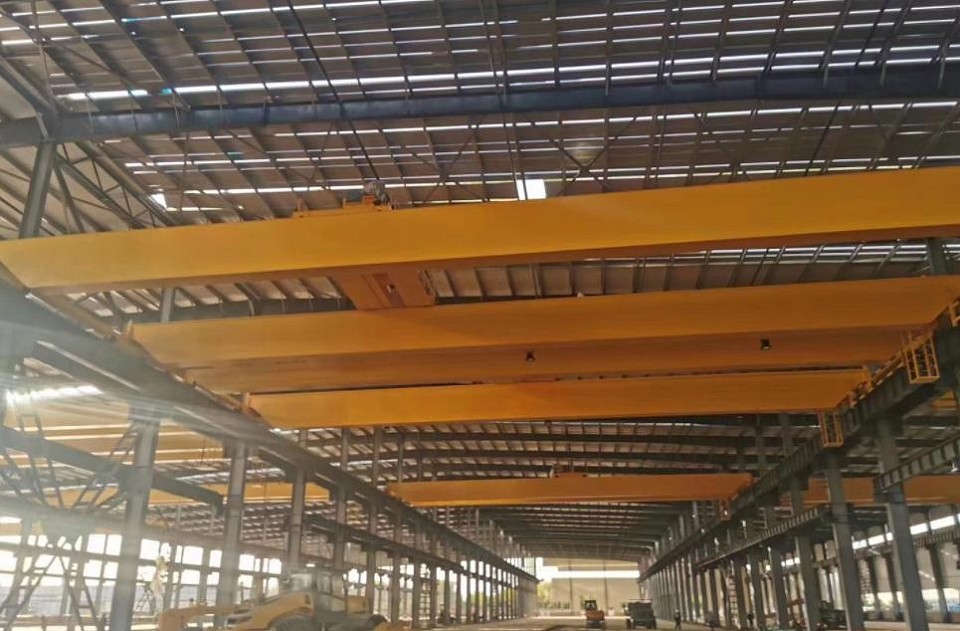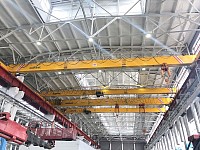Steel Structure Solutions for Multi-Crane Operations
In modern industrial environments, overhead cranes are essential for efficient material handling, particularly when dealing with heavy loads. Industries such as steel manufacturing, precast concrete production, shipbuilding, and power plant construction rely heavily on heavy-duty overhead cranes to transport large and bulky items across their facilities. However, when multiple cranes must operate simultaneously within the same building, the design of the supporting steel structure becomes a critical engineering challenge. Proper design ensures safety, efficiency, and longevity while minimizing structural deflections and operational conflicts.
Understanding the Requirements of Heavy Duty Overhead Cranes
Heavy-duty overhead cranes, typically classified as A5, A6, or higher according to ISO or FEM standards, are capable of lifting loads ranging from tens to several hundred tons. The cranes are mounted on girders or rails integrated into the building’s steel framework. When multiple cranes are required, several factors must be considered:
Load Distribution: Each crane imposes vertical and horizontal forces on the supporting steel structure. This includes the weight of the crane itself, the lifted load, dynamic effects during acceleration or deceleration, and impact loads due to sudden stops or emergency braking. When two or more cranes share the same runway beams, these loads can overlap, necessitating careful calculation of maximum probable load cases.
Crane Geometry: The span, lifting height, hook approach, and trolley travel range define how cranes move within the building. Multiple cranes must be spaced adequately to prevent collisions, with consideration for cantilevered hoists or long trolleys that extend beyond the main beam.
Operational Simultaneity: When designing for multiple cranes, engineers must assume scenarios where all cranes are in use simultaneously. This “worst-case” condition ensures the steel structure can resist maximum combined loads without excessive deflection or instability.
Structural Considerations for Multiple Cranes
Designing a steel structure to accommodate multiple heavy-duty cranes requires a combination of advanced structural analysis, careful material selection, and adherence to industry standards. Key considerations include:
1. Runway Beams
The runway beams, typically built from wide flange steel sections, support the crane wheels and transfer loads to the building columns. For multiple cranes:
Increased Load Capacity: Runway beams must be designed for the sum of the crane loads plus dynamic effects. Engineers often introduce a load distribution factor to account for the probability of simultaneous crane operation.
Lateral Stability: Sideward forces generated by cranes, especially during acceleration or cornering, can induce lateral bending. Additional stiffeners or cross-bracing between beams may be required.
Deflection Limits: Excessive deflection of runway beams can affect crane operation and lead to uneven wheel loading. International standards, such as FEM 1.001 and CMAA specifications, provide guidelines for allowable deflections. Maintaining deflection within limits is particularly important when multiple cranes operate simultaneously.
2. Supporting Columns and Bracing
Columns supporting the runway beams must resist vertical loads, lateral forces, and torsional moments:
Column Strength: Columns should be sized for the combined vertical load of all cranes plus the dead weight of the structure. For heavy-duty cranes, H-shaped or box-section columns are often preferred due to higher moment capacity.
Bracing Systems: To prevent lateral buckling, bracing between columns or between columns and roof trusses may be required. X-bracing, K-bracing, or portal bracing can improve rigidity, especially when cranes induce significant horizontal forces.
Foundation Interaction: Columns must transfer loads to foundations without excessive settlement. Soil bearing capacity, foundation size, and crane impact factors should be considered in tandem with the steel frame design.
3. Roof and Gantry Integration
Heavy-duty overhead cranes can be single or double girder designs. Double girder cranes often require higher lifting heights, impacting roof design:
Roof Clearance: Adequate vertical clearance must be maintained above the crane trolley to ensure full lifting capacity without obstruction.
Crane Stops and Limit Switches: Structural provisions should allow installation of end stops, limit switches, and other safety devices.
Roof Truss Interaction: Roof trusses should not interfere with crane operation. In some cases, trusses can double as lateral braces for runway beams, enhancing the structure’s stability.
4. Dynamic Considerations
Unlike static loads, cranes introduce dynamic effects that can be particularly significant when multiple units operate simultaneously:
Impact Factors: Accelerating and decelerating cranes produce dynamic forces. These must be multiplied by static loads to estimate total effects.
Vibration and Fatigue: Repeated crane operations can induce vibrations in the steel frame. Over time, this can lead to fatigue failure if the structure is not properly reinforced.
Seismic and Wind Loads: In regions prone to seismic activity or high winds, the design must account for lateral forces in combination with crane loads, especially for long-span industrial buildings.
5. Collision and Operational Safety
Safety is paramount in facilities with multiple cranes:
Spacing: Minimum spacing between adjacent cranes is essential to prevent collisions. This includes consideration for trolley sway, load swing, and operator error.
Overlap Restrictions: When cranes operate on the same runway but at different elevations, clearances must prevent interference.
Control Systems: Modern facilities may employ synchronized crane operation or anti-collision systems. The steel structure must accommodate these technologies, often including provisions for cable trays, sensors, and communication systems.
Material and Fabrication Considerations
Steel Grade: High-strength structural steel, such as ASTM A992 or equivalent, is typically selected for runway beams and columns to maximize load capacity while minimizing weight.
Fabrication Precision: Runway beams must be fabricated with high dimensional accuracy to ensure smooth crane travel and prevent misalignment.
Welding and Bolting: Connections must be designed to resist combined vertical and lateral forces. High-strength bolts and full-penetration welds are common in heavy-duty crane structures.
Design Standards and Codes
Adhering to recognized codes ensures reliability and safety. Key standards include:
ISO 4301 / FEM 1.001: Guidelines for crane classification, load ratings, and structural requirements.
CMAA 70 / 74: Standards for the design of overhead and gantry cranes, including load factors, deflection limits, and impact considerations.
AISC Steel Construction Manual: Provides detailed guidance on member sizing, connections, and lateral stability.
Case Studies and Practical Examples
Consider a steel fabrication facility requiring three 50 ton overhead cranes operating on the same 40-meter runway. Each crane has a span of 20 meters and lifting height of 12 meters. Design engineers must:
Calculate the maximum combined vertical load, including crane weight, lifted load, and dynamic factors.
Design runway beams with sufficient section modulus and lateral bracing to prevent bending and torsion.
Ensure columns are sized for maximum axial load and lateral stability, incorporating foundation design and soil bearing capacity.
Check for crane-to-crane clearance, ensuring that operational safety is maintained.
Include vibration damping measures to reduce fatigue risk over long-term operation.
This approach ensures safe, reliable, and efficient crane operation while maximizing the utility of the industrial building.
Conclusion
Designing steel structures to accommodate multiple heavy-duty overhead cranes requires a careful balance of load-bearing capacity, lateral stability, dynamic performance, and operational safety. Engineers must consider crane geometry, simultaneous operation, material selection, and compliance with international standards to ensure the longevity and efficiency of the facility. By integrating these considerations early in the design process, industrial buildings can support multiple cranes safely, enabling seamless material handling and contributing to overall operational productivity.
A well-designed steel structure not only provides the physical support needed for heavy-duty cranes but also enhances safety, reduces maintenance costs, and ensures that industrial operations can meet the demands of modern production. With proper planning and attention to detail, facilities can achieve maximum performance from their crane systems while safeguarding workers and equipment.


